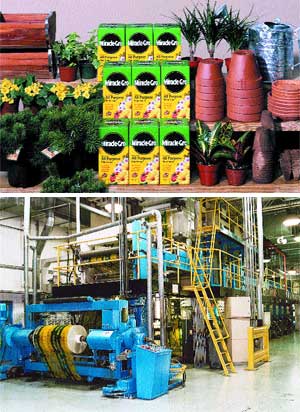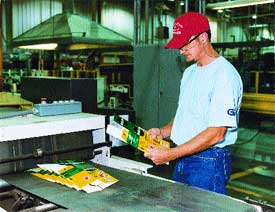Rain or shine, Miracle-Gro cartons blossom
January 29, 2014
For amateur gardeners, last spring brought about more than the budding of plants and flowers. It also marked a rebirth in the utility and aesthetics of the packaging for a longtime gardening aide, Miracle-Gro® plant and lawn foods from The Scotts Co. After the seeds of change had been planted by its larger home and garden retail customers, Marysville, OH-based Scotts reintroduced its plant care products in May, '01 in fade- and moisture-resistant cartons developed by converter Graphic Packaging Corp.
Packed in gravure-printed and embossed cartons in full flower are products such as Miracle-Gro® All-Purpose Plant Food, Miracle-Gro® Rose Plant Food, Miracle-Gro® Tomato Plant Food, and Miracle-Gro® Lawn Food, among others, in 1.5-, 3-, 5-, 10- and 12.5-lb sizes. Vibrant and sturdy, the new packaging has expanded the product line's marketing opportunities. Says Peter Sload, assistant brand manager for Scotts Miracle-Gro Products, "The carton improves our presence for many retailers, particularly as Miracle-Gro is often merchandised outdoors in the live-goods section."
A challenging proposition
In 1950, Horace Hagedorn, an advertising executive, and his partner, Otto Stern, invested $2,000 to introduce a new product to make house and garden plants stronger, healthier and more beautiful. Nearly 40 years later, The Scotts Co., which merged with the resultant successful business of Stern's Miracle-Gro Products in 1995, spent a good deal more money, along with nearly a year of R&D to bring those same benefits to the packaging of that fertilizer product.
In 1999, Scotts approached folding carton producer Graphic Packaging, headquartered in Golden, CO, with a challenge for the converter's Performance Products Division. Explains GPC marketing vp John Grathwohl, PPD specializes in high-volume, value-added carton products–such as film-to-paperboard and paperboard-to-paperboard laminations, along with metallization–that provide enhanced graphics and strength, as well as moisture, odor and oxygen barrier properties.
Scotts' proposition, routed to GPC's Lawrenceburg, TN, PPD facility, was for the converter to come up with a folding-carton structure that could withstand the daily irrigation and natural precipitation of an outdoor garden environment, as well as remain fade-resistant when exposed to strong summer sunlight. Scotts' preference for this type of structure over solid plastic materials as a replacement for its existing folding cartons sprouted, Grathwohl believes, from its desire to maintain its extant filling capabilities.
|
New cartons for Miracle-Gro fertilizer products, top, are a film-and-paperboard lamination that is fade- and moisture-resistant. Graphics are reverse-gravure-printed on a PET film web, above, using custom-formulated inks. |
The design of the structure would be based on GPC's multipatented Composipace technology. In this process, various film structures, inks and paperboard are combined in a lamination that provides application-specific properties. To achieve this structure, GPC's PPD reverse-rotogravure-prints package graphics on the inside wall of a thin, flexible and transparent film, which is then vacuum-metallized behind the inks and extrusion-laminated to paperboard.
But the Scotts' project was no ordinary Composipac job. "In this case, we had the issues of water resistance over a long period of time, which we'd never designed for, and we had to achieve one-thousand hours of fade resistance, which is probably four times what we've designed around before," says Grathwohl. "In addition, we had to have a carton that would run through their filling lines."
Tests prove fruitful
Before GPC could even begin formulating potential structures for Scotts, the lawn and garden care company required them to design tests that would establish a baseline for fade- and moisture-resistance characteristics. Says Grathwohl, "The first three to four months of the development phase were devoted to evaluating known structures to see how close we were to addressing their first requirement, which was weatherability."
The first hurdle–"a very restrictive test," according to Grathwohl–was an intense light test that required inks to withstand 1,000 hours of exposure to intense light without fading. The challenge, he says, was to find pigments that could not only pass this severe fade test, but that also could be blended with resins to provide the necessary film and lamination adhesion required.
A strong advantage for the Lawrenceburg facility, notes Mark Sinclair, GPC's director of R&D, is its in-house computerized ink-blending system. The equipment allows the plant to create unique ink systems by blending several high-strength pigments from outside suppliers with resins on-site. For the Scotts project, an ink system was developed through a cooperative effort with three major ink companies, which GPC declined to identify.
|
Using either one of its two in-house extrusion laminators, GPC 'marries' the printed PET, print-side-down, to a specially selected SBS with a PE adhesive, at speeds up to 1,000 fpm. |
The second test, developed and conducted at GPC's Lawrenceburg facility, with assistance from the company's pilot plant in Golden, was a wetting test. Explains Grathwohl: "It actually consisted of a simulated sprinkler. We would sprinkle the products and allow just a certain amount of the water to remain in contact with the carton, and then we would drain the water to simulate what would happen with a pallet of products sitting under a sprinkler in an outdoor store. We then continued sprinkling the products on a repetitive basis over a couple-month period of time."
GPC says it was looking for a dense fiberboard that would be modified enough that water could not permeate quickly through the raw edge. Selected for the project was an SBS paperboard stock ranging in thickness from .021 to .030, depending upon the size of the container. Two suppliers, which could not be mentioned, provided the board material.
Lastly, a stable, oriented polyester terephthalate film, developed in conjunction with DuPont Teijin Films™ was selected for a number of its characteristics. Among them its high print reproduction, as well as its ability to resist moisture while offering the needed ink-adhesion properties. Being a stiffer film, it also provided the control necessary for lamination, die-cutting and embossing. "In addition," Sinclair tells PD, "the film exterior had to exhibit a predictable coefficient of friction, or slipperiness, to allow the cartons to perform at their peak during filling, but it also had to be glossy to maintain graphics on the store shelf–a major goal of Scotts."
Making a 'miracle-gro'
Turning over a new leaf, GPC concluded the testing and design phase of the Miracle-Gro project and began production of the cartons at its Lawrenceburg facility early in '01.
One of six PPD sites operating in GPC's network of 20 U.S. production facilities, the Lawrenceburg plant specializes in gravure printing, metallizing and laminating, and offers a range of finishing techniques. In addition to blending its own inks, the site can also produce its own blown PE film. The 280,000-sq-ft plant employs roughly 400 people to create both side-seamed and flat blank cartons with value-added features.
Says Sinclair, "Lawrenceburg is a very unusual plant due to its mix of printing and lamination capabilities. It looks a little like a flexible plant on the front end, and like a folding carton plant on the back end."
To make the "miracle-gro," GPC first reverse-prints the clear PET film on either one of its two Polytype Polymaster gravure presses from Polytech S.p.A. Sinclair says that gravure is the printing process of choice at this facility because it allows for the best reproduction quality on film and provides "excellent predictability." Speed is another advantage: GPC's Polymaster presses can run from 700 to 1,000 fpm. Film for the Miracle-Gro job is printed in either seven or eight colors, depending upon the product.
While most typical Composipac films are metallized using one of two custom-modified vacuum metallizers, the Scotts job moves straight from printing to lamination. There, two Black Clawson extrusion laminators, also running at 1,000 fpm, adhere the film, print side down, to the SBS board using a PE adhesive from several unnamed suppliers.
|
Side-sealed cartons are inspected after having been die-cut and embossed, as well as printed in one color on the inside wall, before they are sent to Scotts' copackers. |
The next stage, die-cutting and embossing, is performed simultaneously in the die head of one of the facility's four Zerand platen die-cutters. Another first for Scotts, the embossing enhances the appearance of flower and vegetable graphics depicted on the front panels of some Miracle-Gro varieties. Cartons are also one-color-printed on the inside with additional product information as they pass through the Zerand equipment. At the end of the line, cartons are side-seamed on one of eight cutters, supplied by either Jagenberg or International Paper Box Machine, according to the specifications provided by Scotts' copackers.
In full bloom
In the end, comments Sinclair, the redesign of the Miracle-Gro carton not only satisfied its primary requirements, but it also germinated some secondary benefits, as well. "From a marketing standpoint, I thought this was a very intriguing project," he says. "Although the change was inspired by the large home and garden companies needing cartons that were flexible enough to be displayed both inside and outside, there were many other benefits that resulted from the redesign. These included the enhanced aesthetics of the package, resulting from the glossier surface and the embossing of the flower and vegetable graphics, and the increased value to consumers. For example, as a consumer, if you forget the product out in your garden overnight, and it rains, the package won't fall apart and spread fertilizer all over."
Agrees Scotts' Sload, "The new carton provides greater integrity at the retail level. It increases stacking strength 32 percent when exposed to moisture, and the embossing conveys the high quality of the product found inside."
He adds: "Both the trade industry and our consumers have given us very positive feedback on the new packaging."
More information is available:
Folding carton converting: Graphic Packaging Corp., 800/677-2886. Circle No. 208.
Film: DuPont Teijin Films™, 800/635-4639. Circle No. 209.
Gravure presses: Polytech S.p.A., 39 321 920111. Circle No. 210.
Laminators: Black Clawson Converting Machinery LLC, 315/598-7121. Circle No. 211.
Die-cutters: Zerand Corp., a Cerutti Group co., 262/827-3800. Circle No. 212.
Gluers: Jagenberg, Inc., 860/741-2501. Circle No. 213.
Gluers:International Paper Box Machine Co., Inc., 603/889-6651. Circle No. 214.
About the Author(s)
You May Also Like





